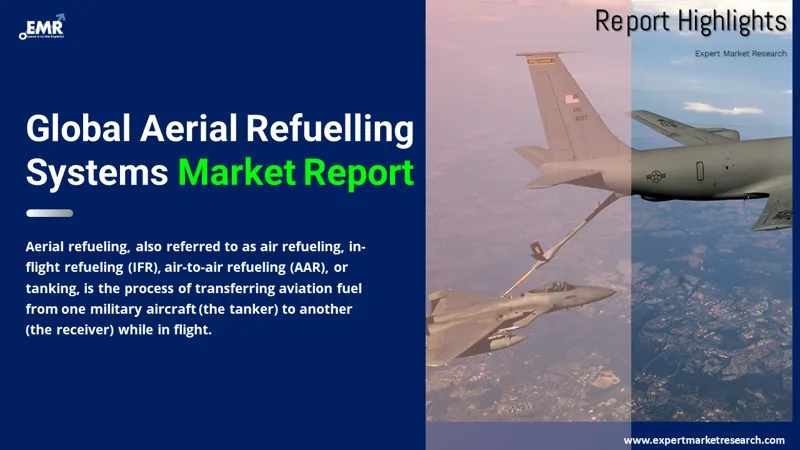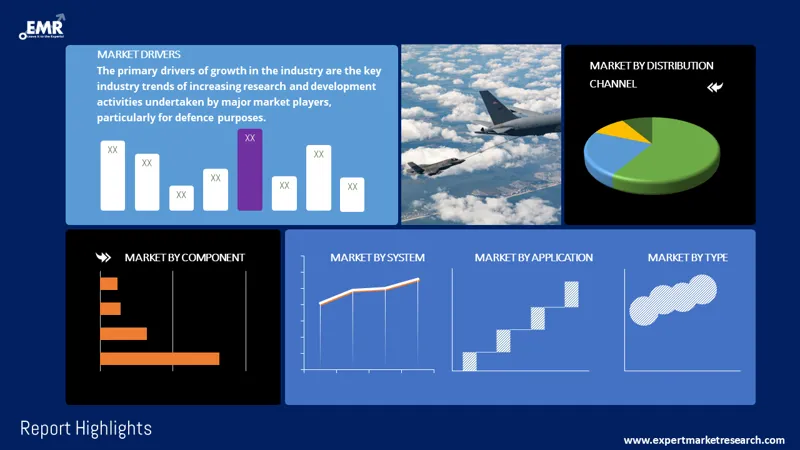
Consumer Insights
Uncover trends and behaviors shaping consumer choices today
Procurement Insights
Optimize your sourcing strategy with key market data
Industry Stats
Stay ahead with the latest trends and market analysis.
The global aerial refuelling systems market is expected to grow at a CAGR of 4.50% in the forecast period of 2026-2035 to attain USD 892.05 Million by 2035.
Base Year
Historical Period
Forecast Period
Compound Annual Growth Rate
4.5%
2026-2035
*this image is indicative*
| Global Aerial Refuelling Systems Market Report Summary | Description | Value |
| Base Year | USD Million | 2025 |
| Historical Period | USD Million | 2019-2025 |
| Forecast Period | USD Million | 2026-2035 |
| Market Size 2025 | USD Million | XX |
| Market Size 2035 | USD Million | 892.05 |
| CAGR 2019-2025 | Percentage | XX% |
| CAGR 2026-2035 | Percentage | 4.50% |
| CAGR 2026-2035 - Market by Region | Asia Pacific | 5.8% |
| CAGR 2026-2035 - Market by Country | India | 6.7% |
| CAGR 2026-2035 - Market by Country | China | 5.6% |
| CAGR 2026-2035 - Market by Type | Unmanned | 5.0% |
| CAGR 2026-2035 - Market by System | Autonomous | 5.0% |
| Market Share by Country 2025 | Germany | 4.1% |

Read more about this report - REQUEST FREE SAMPLE COPY IN PDF
Tanker aircraft demand is expected to rise in tandem with increasing defence budgets in emerging economies, consequently boosting industry sales. With the number of sorties away from ground bases, refuelling has become a critical mission component. The AAR will help deploy to another country on short notice. The aerial refuelling systems industry is predicted to expand as more reliable approaches for increasing aircraft endurance and range are adopted. Aerial refuelling tankers are being upgraded to improve their airspeed, altitude, and range. Industry leaders are working to improve severe-environment suitability, lower lifecycle costs, autonomous service, and roll-on/roll-off capability. Due to the existence of the main refuelling fleets, North America accounted for a significant market share in 2019. About 400 KC-135s and 55 big KC-10s are in the US fleet. The US Air Force and Marine Corps are modernising their fleets in order to maintain their aerial dominance, which would have a positive effect on regional business growth. Furthermore, to improve refuelling capabilities, the area is witnessing the replacement of old refuelling tankers with more versatile ones. This is expected to boost the market growth of aerial refuelling systems.
The method of switching aviation fuel from one military aircraft (the tanker) to another (the receiver) during flight is known as aerial refuelling, also known as air refuelling, in-flight refuelling (IFR), air-to-air refuelling (AAR), and tanking.
The market is bifurcated in terms of type into
The market is divided on the basis of systems into
In terms of component, the market is categorised into
The market is segmented by application into
By distribution channels, the market is bifurcated into
Based on region, the market can be divided into

Read more about this report - REQUEST FREE SAMPLE COPY IN PDF
| CAGR 2026-2035 - Market by | Country |
| India | 6.7% |
| China | 5.6% |
| Brazil | 4.9% |
| Australia | 4.0% |
| USA | 3.7% |
| Canada | XX% |
| UK | XX% |
| Germany | 3.3% |
| Italy | XX% |
| Japan | XX% |
| Saudi Arabia | XX% |
| Mexico | XX% |
| France | 3.1% |
Air-to-air refuelling is becoming more common as it allows planes to take off with less weight. Guns, freight, and staff are all carried on defence aircraft, and if the plane is fully loaded, it may be difficult for it to take off. Air-to-air refuelling allows aircraft to be topped off for long-distance flights as well as loitering. This trend is propelling the aerial refuelling industry forward. Furthermore, inflight refuelling, also known as air-to-air refuelling, has been proposed as a way to reduce fuel usage on long-distance flights. Gas charges will be reduced as a result of the reduced fuel consumption, which will benefit both the airlines and the air forces financially. The demand for aerial refuelling is set to be fuelled by air-to-air refuelling. Furthermore, leading players' increased research and development is driving market growth, and this trend is projected to continue in the forecast period. The military industry and commercial airlines are the end users of the aerial refuelling industry. The air force of all major defence forces around the world uses aerial refuelling extensively because it allows fighter/combat aircraft to take off with less fuel and more payload. During long-haul operations, the commercial carrier uses aerial refuelling services, thereby aiding the market growth.
The report gives a detailed analysis of the following key players in the global aerial refuelling systems market, covering their competitive landscape, capacity, and latest developments like mergers, acquisitions, and investments, expansions of capacity, and plant turnarounds:
The comprehensive EMR report provides an in-depth assessment of the market based on the Porter's five forces model along with giving a SWOT analysis.




*While we strive to always give you current and accurate information, the numbers depicted on the website are indicative and may differ from the actual numbers in the main report. At Expert Market Research, we aim to bring you the latest insights and trends in the market. Using our analyses and forecasts, stakeholders can understand the market dynamics, navigate challenges, and capitalize on opportunities to make data-driven strategic decisions.*
Get in touch with us for a customized solution tailored to your unique requirements and save upto 35%!
The market is projected to grow at a CAGR of 4.50% between 2026 and 2035.
The market is estimated to witness a healthy growth in the forecast period of 2026-2035 to reach USD 892.05 Million by 2035.
Demand for lesser weighted flights and the increasing investments in military are major drivers of this market.
Increasing research and development activities taken up by major players in the market, especially for defence purposes and the demand for reduced fuel usage are the key trends driving the growth of the market.
The major regions in the market are North America, Latin America, the Middle East and Africa, Europe, and the Asia Pacific.
The various types of aerial refuelling systems in the market are manned and unmanned.
The major systems in the market are probe and drogue, flying boom, and autonomous, among others.
The components of aerial refuelling systems include refuelling pods, refuelling probes, drogues, hoses, and boom, among others.
The various applications of aerial refuelling systems in the market include military aircraft, helicopters, commercial aircraft, and UAV, among others.
The leading distribution channels of aerial refuelling systems in the market are OEM and aftermarket.
The key players in the global aerial refuelling systems market are Lockheed Martin Corporation, Cobham Mission Systems Wimborne Limited, Eaton Corporation plc, and Safran Aerosystems, among others.
Explore our key highlights of the report and gain a concise overview of key findings, trends, and actionable insights that will empower your strategic decisions.
| REPORT FEATURES | DETAILS |
| Base Year | 2025 |
| Historical Period | 2019-2025 |
| Forecast Period | 2026-2035 |
| Scope of the Report |
Historical and Forecast Trends, Industry Drivers and Constraints, Historical and Forecast Market Analysis by Segment:
|
| Breakup by Type |
|
| Breakup by System |
|
| Breakup by Component |
|
| Breakup by Application |
|
| Breakup by Distribution Channel |
|
| Breakup by Region |
|
| Market Dynamics |
|
| Competitive Landscape |
|
| Companies Covered |
|
| Report Price and Purchase Option | Explore our purchase options that are best suited to your resources and industry needs. |
| Delivery Format | Delivered as an attached PDF and Excel through email, with an option of receiving an editable PPT, according to the purchase option. |
Single User License
One User
USD 3,999
USD 3,599
tax inclusive*
Datasheet
One User
USD 2,499
USD 2,249
tax inclusive*
Five User License
Five User
USD 4,999
USD 4,249
tax inclusive*
Corporate License
Unlimited Users
USD 5,999
USD 5,099
tax inclusive*
*Please note that the prices mentioned below are starting prices for each bundle type. Kindly contact our team for further details.*
Flash Bundle
Small Business Bundle
Growth Bundle
Enterprise Bundle
*Please note that the prices mentioned below are starting prices for each bundle type. Kindly contact our team for further details.*
Flash Bundle
Number of Reports: 3
20%
tax inclusive*
Small Business Bundle
Number of Reports: 5
25%
tax inclusive*
Growth Bundle
Number of Reports: 8
30%
tax inclusive*
Enterprise Bundle
Number of Reports: 10
35%
tax inclusive*
How To Order

Select License Type
Choose the right license for your needs and access rights.

Click on ‘Buy Now’
Add the report to your cart with one click and proceed to register.

Select Mode of Payment
Choose a payment option for a secure checkout. You will be redirected accordingly.
Gain insights to stay ahead and seize opportunities.

Get insights & trends for a competitive edge.

Track prices with detailed trend reports.

Analyse trade data for supply chain insights.

Leverage cost reports for smart savings

Enhance supply chain with partnerships.

Connect For More Information
Our expert team of analysts will offer full support and resolve any queries regarding the report, before and after the purchase.
Our expert team of analysts will offer full support and resolve any queries regarding the report, before and after the purchase.
We employ meticulous research methods, blending advanced analytics and expert insights to deliver accurate, actionable industry intelligence, staying ahead of competitors.
Our skilled analysts offer unparalleled competitive advantage with detailed insights on current and emerging markets, ensuring your strategic edge.
We offer an in-depth yet simplified presentation of industry insights and analysis to meet your specific requirements effectively.
Share